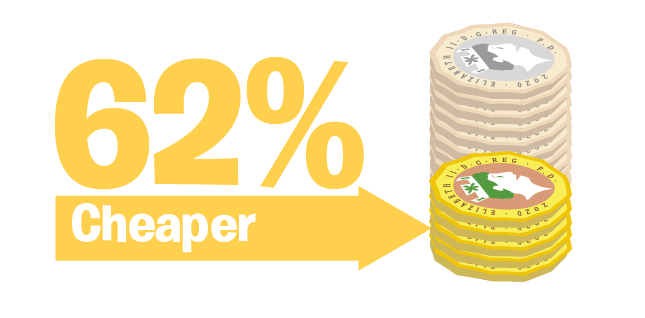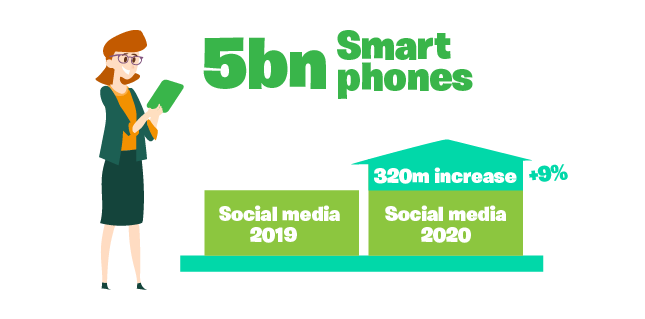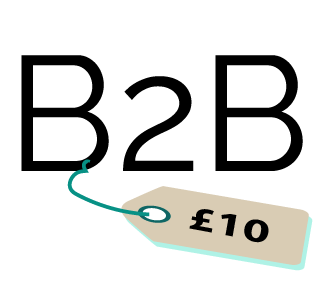Content marketing is an important marketing strategy. Great content marketing builds a strong relationship with your intended audience. It should provide content which has value, relevance and is consistent.
To help you get to grips with content marketing, we’ve put together a three part guide. To begin, we’re looking at what content marketing is and why you should be doing it.
Let's get started
Consumers today are smart. They have shorter attention spans, and they are fed up with ‘in-your-face’ advertising.
They don’t just want to know what you have to sell, they also want to know why you’re selling and how you can help them.
And that is where content marketing can help.
According to various studies, content marketing produces 3 times more leads per dollar spent.
Not only it is more effective, but it also costs 62% cheaper than any other outbound marketing channel. 
Most importantly, unlike paid advertisements, consumers love them. 70% of consumers prefer knowing a company through content than through ads.
With a high ROI and low cost, it’s no wonder that even the old giants like Nike and Coca-Cola have their own blogs.
So, what is content marketing?
“Content marketing is a technique of creating and distributing relevant and valuable content to attract, acquire, and engage a clearly defined and understood target audience- with the objective of driving profitable customer action.”
This means that you as a business needs to start considering putting content out to connect with your market.
And, if you are already publishing content, you need to care about the quality of content that you are putting out.
What is Content?

In content marketing, any kind of media (both online or offline) can be considered as content.
Content can be found in the pages of a book or a short video from YouTube.
When we think of content, do we mean books, newspapers, magazine articles, blog posts, and reports?
Not exactly. You see, thanks to the internet our content is no longer just words on paper or images on the screen.
Nowadays, not only do we have content in the form of images, graphs, infographics, and charts. We now also have videos, podcasts, and apps that are interactive for the consumer.
Social media posts on Facebook and Instagram, tweets on Twitter are also content.
Any kind of media distributed digitally on the Internet is content
Unlike traditional marketing materials (billboards, print ads, TV spots), content is not promotional.
This right here is the underlying key difference between both forms of marketing. And, it’s crucial to understand this difference if you want to succeed in content marketing.
Content marketing is so effective in today’s world because it doesn’t bombard the consumer’s senses like an overplayed TV ad or radio jingle.
Your content should inform, entertain, help and engage your customers and/or answer all your customer’s questions.
The long-term game plan is to forge a long-lasting relationship with your customer.
So that when the customers need what you are offering, they will remember your content, and they will automatically think of you first.
Powerful benefits of content marketing
It's versatile
The variable cost of content marketing is just one example of how flexible content marketing is.
There’s just so many different ways you can use content marketing to reach your audience.
And let’s not forget the number of ways you can leverage these content for your business’ benefit too.
Not only can content marketing generating sales, it can also be an invaluable tool for generating future leads. In addition, it fosters trust and opens a dialog for other purposes (such as gathering feedback or seeking funding).
It focuses on relationships and narrative
If you really want to reach an audience and encourage them to take action, then you need to appeal to them on an emotional level.
And this is where the magic of content marketing really shines!
It’s your opportunity to create new relationships, showcase your business’s personally and – key to content marketing – build trust.
We’re in an era where consumers trust each other more than they do brands. It’s now, more than ever, essential to have a real ‘voice’ behind your business. A voice that connects with your audience and builds rapport with them.
Once you’ve done this, you’ll not longer be a faceless entity, but a human organisation run by people just like everybody.
This is a fantastic strategy for those with their eye on the long-term aiming to build long-term relationships with their customers and clients.
It's not showing any signs of slowing down
Content marketing is still at the very core of digital marketing, with 90% of marketers currently using it to target their customers. And it’s only set to get bigger.
The number of people carrying smart devices 24/7 is also growing day by day. Today, we have nearly 5 billion smartphone owners in the world.
Also, new social platforms are continuously providing new opportunities for marketers to capitalise. In the past year alone, social media users have grown by 9%, an increase of around 320 million.

With popular new visual apps like TikTok gaining traction, it’s easy to produce new types of kind of content that conveys real value for users.
Become an authority
The great thing about publishing regular, engaging content is that it helps to build an impression of your brand to consumers.
If you’re the source answers their search query, they’re going to view you as an authoritative figure. If the content you’re sharing is informative and helpful, they’ll think highly of your brand and keep coming back for more.
Similarly, social and external linking can be a valuable and easy way to share your content. By doing so, you’re more likely to be perceived by others as an established thought leader in your industry.
Creating your content brand
The content brand is, simply put, the face of your content.
The core of your content marketing strategy is your content brand.
It’s all about telling your story and bringing this story in front of your audience.
But why a story? It’s simple – Your story creates a narrative that people can relate to and follow.
And just like traditional branding, your content brand helps people view your content and view you as a content publisher.
But unlike regular branding, content branding is a more customer-centric approach.
Rather than sending your brand to reach every corner of your market, in content branding, your sole mission is to provide the content your audience wants.

That means creating and publishing content by putting the audience first, and through this content, you establish the brand.
Needless to say, a content brand strategy makes all the difference between a successful and a mediocre campaign.
5 Key steps to getting started with content marketing.
So, let’s dive right in and look at the 5 critical steps to build a content marketing strategy which really connects with your audience.
1. Understand your customers
This is undoubtedly the foundation of any marketing strategy, and it’s still just as important in content marketing.
Before you publish any content, you have to know what sort of content your customer likes. There are many ways you can find out their demographics and tastes. Examples include, via Facebook groups, Instagram hashtags, Reddit sub-forums, or even Quora.
2. Serve your customers’ needs
Publishers with good content brand always put the customers’ needs before their own.
They put out content that is helpful or enjoyable to the customer, rather than selling their product or service.
If you can continuously meet the customers’ needs, you can reap the benefits of customer loyalty and top-of-mind positioning.
3. Staying consistent
Just like your regular brand, your content brand needs to be consistent. All your content has to deliver the same message to your customers, so not to confuse them.
That includes keeping a pulse on the sentiments of your customers, as well as their opinions.
Keep up-to-date with relevant trends through social media hashtags, magazines, journals, or your industry’s leading newsletters.
4. Build Authority
The almighty authority – one of the key pillars of SEO success, plays a crucial role in content marketing as well.
You need to establish yourself as the go-to authority for any information that is relevant to your niche.
In other words, you need to become the expert in your customers’ eyes. Not just an expert in knowledge, but a leader of your product or service.
5. Quality
To maintain quality and consistency, your brand has to be always producing content that is high calibre. More importantly, they must be fresh.
If you can produce content ahead of your competition, you’ll attract more eyeballs to your brand.
This means not just pushing out content quickly, but ensuring it’s enriching and information. It goes back to the point of; what would consumers get out of reading this?

Putting your content strategy together
Your content brand strategy includes everything from your initial brand concept to your content ideas list.
It is a good idea to put your strategy in writing or in a word document so that you can share it with employees and your content producers.
While they don’t need a deep dive into your customers’ persona, but they need a good, solid idea of your audience’s likes, dislikes, tastes, and problems so that they can produce content that’s in line with those things.
Topic ideas and guidelines
Besides the key information about your audience, your content strategy needs to include topic ideas and guidelines.
Links to the previous content or the types of content you’re aiming helps to give an idea to your content producers.
Your guidelines are the rules for creating content. They include the nuts and bolts information. These include article length and composition, as well as editorial guidelines. Editorial guidelines help to encompass tone of voice, writing style, as well as what words or phrases to avoid.
Content creation process
Outline the content creation process that goes from the idea brainstorming phase to the publishing of content.
It should include a publishing schedule and where you’ll post content. Be as detailed as possible.
If you’re creating content yourself, decide when you’ll do it. You can either set aside time on a regular basis, such as once a week. Find a way to implement it into your daily routine.

If you are outsourcing your content, work with the content creator so that their creation schedule fits your posting schedule. Get into a flow so that there are no gaps.
Monitoring your content
Once content is published, you’ll need to follow the content, such as for comments on social media or on your blog.
Responding to comments and replies promptly encourages engagement with your readers. Comments are also an excellent source of feedback from your audience.
Feedback is great for improving your content so that your audience will enjoy them more.
Remember, your content strategy should be firm but flexible. Over the course of creating and publishing content, you may need to make changes to better suit your audience’s needs.
Need more help?
Not sure where to begin on creating your content strategy? We can help you to create and implement a results-driven strategy that will increase your traffic, leads and sales.
Contact us today to arrange an obligation-free chat.
Alternatively, check out parts two and three of this guide:







